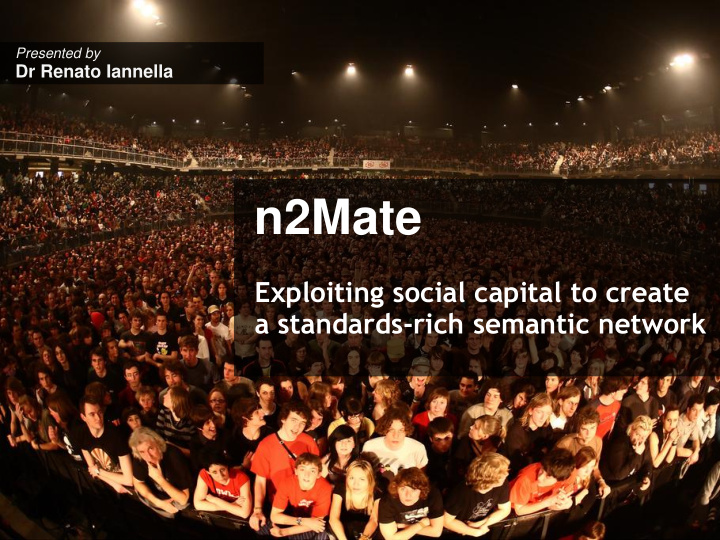



Presented by Dr Renato Iannella n2Mate Exploiting social capital to create a standards-rich semantic network
• David Peterson BoaB interactive david@boabinteractive.com.au • Anne Cregan National ICT Australia anne.cregan@nicta.com.au • Rob Atkinson CSIRO Land & Water rob.atkinson@csiro.au • John Brisbin BoaB interactive john@boabinteractive.com.au
What's the great thing about standards? There are so many to choose from.... and if you can't find one you like, you can always create your own. …the Standard problem with Standards…
A minimal (or at least manageable) number of vocabularies for tagging open data Highly re-used Densely interlinked Otherwise we get killed by the n-squared mapping problem.... very sparse network with minimal interoperability
1.Foundational Angle Create foundational techniques for concept definition, so you get interoperability for free 2.Automated Matching Angle Improve automated matching techniques 3.Social Angle Encourage more people to use the same ontologies to describe their data, not create new ones.
Currently, it is too hard to answer the question "Is there an ontology out there that is right for me?" The rankings for ontologies only reflect the likelihood that a surfer will navigate to the document. We would like a rank based on frequency of use as a Semantic Web document, and we would like to be able to assess suitability for our intended use case
Ironic as it sounds, we need metadata about the vocabulary to make an informed choice about whether it suits the purpose Who? ◦ owns it, created it, maintains, uses it, endorses it? What? ◦ domain, context, process - intended to use, suitability? Quality of Service? ◦ accurate? reliable? verifiable? up-to-date? available?
Popularity Rankings ◦ How many SWDs reference this vocabulary/artefact? Authority Badges ◦ A way to assert an authority claim over an artefact Related to ◦ Who uses it? Which vocabularies do my friends or respected cohorts use? Trust & Satisfaction rankings ◦ Trusted? How useful? Ratings? QoS? ◦ Hero worship - most interlinked
A researcher is preparing her research plan on a section of the Great Barrier Reef. Although she is an experienced marine scientist, she is new to the GBR and to her host research facility.
Semantic project depends on interlinkage of ontologies, vocabularies, and standards Humans are central to that effort How to get humans involved effectively?
“Who’s doing what” is the central question Obvious failures: lack of interlinkage
Social Network: semantic-web@w3.org Query ◦ “…So the question is, can you give me pointers to any ontologies (in RDF(S)/OWL) used in the e- culture or similar projects?” Daniel Schwabe Results ◦ 3 People responded with 7 resource links ◦ “You might be interested…” ◦ “You could also consider…” ◦ “May be some useful ontologies…”
Recognise existing registers and metadata collections Use existing protocols to construct a register of registers network Construct facility with social networking devices Implementation ◦ Re-use and leverage existing tools and standards (self- similarity, fractal integrity)
Account and session manager: Drupal Bookmarking and annotation tool: gnizr Storage of instance data: Sesame Semantic interpretation: MOAT Policy layer: PLING Trust & Governance: POWDER
Falcons Ping the Semantic Web Revyu Sindice Swoogle Talis Watson Govdex (Australian)
Recommend
More recommend